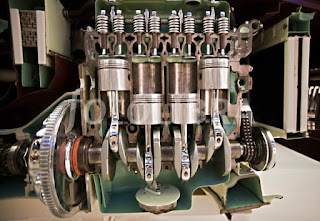A gear train is a mechanical system formed by mounting gearson a frame so that the teeth of the gears engage. Gear teeth are designed to ensure the pitch circles of engaging gears roll on each other without slipping, providing a smooth transmission of rotation from one gear to the next.
Types of gear train are given below:
Usually when two gears mate, they rotate opposite to each other. When we use three gears each mounted on separate shaft, the direction of rotation of the last gear will be same as that of the direction of rotation of first gear. Suppose the number of gears are increased to four the direction of rotation of first and last gear will be opposite to each other. A typical simple gear train is shown in the figure 1.
Types of gear train are given below:
- Simple gear train
- Compound gear train
- Reverted gear train
- Epicyclic gear train
If there is only one gear mounted on each shaft, the gear train is known as simple gear train. that is, each shaft has only one gear.
Usually when two gears mate, they rotate opposite to each other. When we use three gears each mounted on separate shaft, the direction of rotation of the last gear will be same as that of the direction of rotation of first gear. Suppose the number of gears are increased to four the direction of rotation of first and last gear will be opposite to each other. A typical simple gear train is shown in the figure 1.
So from above we can conclude that in a simple gear train, if the no of gears is odd then the direction of rotation of first and last gear will be the same, it it is even, direction of rotation will be opposite.
The speed ratio is given by, (N1/N2) = -(T2/T1), where, N1 is the speed of the driver, N2 is the speed of driven gear, T1 is the no of teeth on driver gear and T2 is the no of teeth on driven gear.
Compound gear train:
If there is more than one gear on a shaft, the gear train is said to be compound gear train. Here speed of rotation of the gears mounted on a shaft will the same and also the direction. By using this arrangement, the power will be transmitted to the shaft which is placed not in the row. The system is compact here. Also we can reduce the size of the gears using this arrangement. This is illustrated in the Figure 2.
Reverted gear train:
If the axes of driver shaft and driven shaft is co-axial, then the gear train is termed as reverted gear train. This is kind of compound gear train. This is illustrated in the figure 3. So reverted gear train may be called as a compund gear train but all compound gear train can not be a reverted gear train. This reverted technology is very much useful when the power is to be transmitted within the less space.
Epicyclic gear train:
This is important gear train compared the said above. In this case, One of the gear is rotating over and around another gear. Epi means over, Cyclic means around. There is an arm connecting such two gears. This gear train finds great application in various field. This is illustrated in the figure 4.








